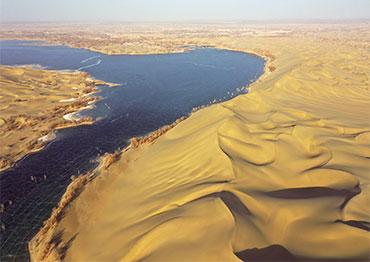The Taklamakan Desert is the world’s 10th largest, stretching 1,000 kilometers and covering 33,000 square kilometers. The Taklamakan roughly sees 100 millimeters of annual rainfall, but with temperatures reaching 40 C in summer, it has an average annual evaporation capacity of 2.5-3.3 liters.
According to Sinopec, snowmelt from the nearby mountains and a rainstorm that hit the nearby Tianshan Mountains caused the flood.
Meteorological authorities issued a red alert for the rainstorm on July 20, warning that parts of Kashgar, the Kizilsu Kyrgyz Autonomous Prefecture and the Aksu Mountains would see moderate to heavy rains later that day. The forecast predicted 40-80 millimeters of rainfall for areas that see an annual average of 100 millimeters.
From the middle of July on, weather forecasts predicted high temperatures and wildfire weather in the region.
Researchers from the Xinjiang Institute of Ecology and Geography (XIEG), Chinese Academy of Sciences, described the Taklamakan flood as an extreme weather event caused by global warming.
Released on August 4, China’s recent “Blue Book on Climate Change” by the National Climate Center supported this conclusion, saying the world’s average temperature rose by 1.2 C compared to the average between 1850 and 1900. China’s average surface air temperature rose at a rate of 0.26 C per decade from 1951 to 2020, the report said.
China’s glaciers are melting. In 2020, the eastern and western branches of Urumqi Glacier No.1 in the Tianshan Mountains receded by 7.8 and 6.7 meters. The report revealed that China’s annual average precipitation has increased 5.1 millimeters every 10 years for the past six decades, with rainstorms becoming more frequent.
“Most regions in Xinjiang are arid and snowmelt from the mountains is the primary water source, especially in July and August when temperatures rise,” Duan Weili, a researcher at XIEG, told NewsChina. “The rainstorm and snowmelt caused the [latest] flood. In fact, floods have been more frequent in Xinjiang in recent years,” he added.
The city of Hami in Xinjiang experienced a sudden torrential rainstorm in July 2018 that ended with 20 people dead and another eight missing.
“The old poem that says ‘Spring wind never comes to Yumen Pass’ is no longer true,” Duan said, referencing the ancient desert outpost along the Great Wall located 80 kilometers northwest of Dunhuang, Gansu Province. “The northwestern areas now see much more rainfall. Actually, precipitation in northwestern China has been increasing these years,” Duan said.
Data on weather.com.cn shows that over the past 60 years, average temperatures in Xinjiang have increased by 0.3 C annually and precipitation has increased by 10 millimeters each year.
“The increased precipitation in areas surrounding the Taklamakan in recent years is because of extreme weather like rainstorms that produce what would normally be one to two years of rainfall in a day. But since overall precipitation there remains low, these changes have not made a tremendous impact on the dry climate,” Duan said.

 Old Version
Old Version

